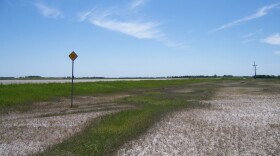Most North Dakotans are familiar with some adaptations birds and mammals have to get through the winter. But what about the invertebrates — insects, for example — and the plants? They have adaptations as well.
Some insects migrate southward to avoid the cold winters. The monarch butterfly is a good example. But those that stay (as eggs, larva, or adults) have to somehow avoid freezing, or tolerate it. You may have noticed lots of boxelder bugs and Eurasian lady beetles around your house last fall. They were looking for a warm place in which to spend the winter. No doubt some of them were successful. Other insects may seek out shelter in a tree, rotting log, soil, or plant gall, sometimes under an insulating cover of snow.
It is not so much the cold temperatures that kill insects, but the formation of ice crystals that tear up cells. Many insects produce substances such as ethylene glycol (a common component of commercial antifreeze) that lower the freezing point of their body fluids. In some cases, their body fluids can be supercooled to -43°F before ice crystals form.
Plants, of course cannot migrate or go find a warm place to spend the winter. So, most plants in northern regions go dormant during the winter. They too must reduce ice formation within their tissues.
Plants become tolerant to subfreezing temperatures by a process called acclimation. The process is complex, but apparently begins as the days shorten in late summer with the movement of various compounds, including sugars and hormones. The plant increasingly becomes more “hardy” or resistant to the potentially damaging effects of below freezing temperatures. Supercooling may also aid in winter survival.
So, as you travel about, give some consideration to how the insects and plants have adapted to North Dakota winters.
Reminder: Great Backyard Bird Count
Also, note that the Great Backyard Bird Count is coming up next week, February 14-17. Spend time watching and counting birds, and submit your counts to help scientists better understand and protect birds around the world.





